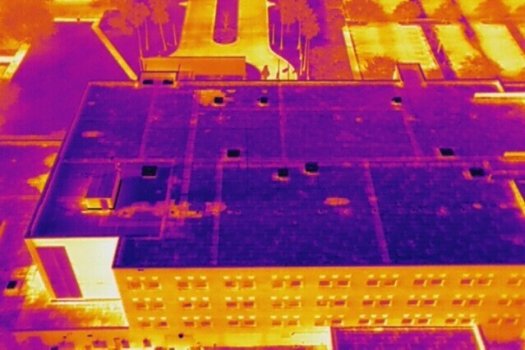K
Kathleen Martin
Guest
For years, roofing professionals have been forced to spend hours on hot and dirty surfaces to do initial inspections of large, flat commercial and industrial roofs. The process is time-consuming, expensive—and potentially dangerous.
Using drones, however, can make inspections faster, safer, and more cost-efficient. And, when drones are equipped with thermal imaging cameras, inspections become even quicker, as well as less risky and more accurate.
Thermal imaging cameras allow inspectors to see infrared energy that is usually invisible to the naked eye. Advanced dual thermal camera payloads present even greater advantages. Dual thermal camera payloads, such as Teledyne FLIR’s VUE® TZ20-R, allow operators to zoom into subjects without loss of resolution. With these systems, operators can perform rapid moisture inspections, detailed examinations of roof-mounted mechanical systems, and much more.
Central to this technology is the use of two cameras. Dual thermal camera payloads for drones pair a wide field of view (FOV) thermal camera with another, narrower FOV thermal camera. By using two cameras, operators can utilize 5x optical zoom without affecting resolution and image quality. This improves the efficiency of thermal drone inspection, increases the speed of inspections, and cuts down on flight times.
Radiometry is another important feature of some dual thermal camera payloads. Cameras with radiometry can measure surface temperature to determine if glowing spots or cool areas on a roof are signs of a problem. Systems like the VUE TZ20-R—which provides accurate radiometry over a wide variety of environmental conditions—are ideal for complete, accurate roof inspections. Thermal cameras without radiometry simply aren’t very helpful.
Given these features, dual thermal camera payloads are great for assessing the condition of large commercial and industrial roofs, but they also help inspectors review the condition of the many mechanical systems often found on these surfaces. Thermal imaging can measure the temperature of generators, HVAC systems, air handlers, duct work, access points, and even solar panels. In addition, they can point out insulation and moisture issues that can impact the integrity of roofs. Accurate temperature and moisture readings can help operators identify potential problems and reduce false positives.
Continue reading: https://www.commercialuavnews.com/using-dual-thermal-imaging-with-drones-to-improve-flat-roof-inspections
Using drones, however, can make inspections faster, safer, and more cost-efficient. And, when drones are equipped with thermal imaging cameras, inspections become even quicker, as well as less risky and more accurate.
Thermal imaging cameras allow inspectors to see infrared energy that is usually invisible to the naked eye. Advanced dual thermal camera payloads present even greater advantages. Dual thermal camera payloads, such as Teledyne FLIR’s VUE® TZ20-R, allow operators to zoom into subjects without loss of resolution. With these systems, operators can perform rapid moisture inspections, detailed examinations of roof-mounted mechanical systems, and much more.
Central to this technology is the use of two cameras. Dual thermal camera payloads for drones pair a wide field of view (FOV) thermal camera with another, narrower FOV thermal camera. By using two cameras, operators can utilize 5x optical zoom without affecting resolution and image quality. This improves the efficiency of thermal drone inspection, increases the speed of inspections, and cuts down on flight times.
Radiometry is another important feature of some dual thermal camera payloads. Cameras with radiometry can measure surface temperature to determine if glowing spots or cool areas on a roof are signs of a problem. Systems like the VUE TZ20-R—which provides accurate radiometry over a wide variety of environmental conditions—are ideal for complete, accurate roof inspections. Thermal cameras without radiometry simply aren’t very helpful.
Given these features, dual thermal camera payloads are great for assessing the condition of large commercial and industrial roofs, but they also help inspectors review the condition of the many mechanical systems often found on these surfaces. Thermal imaging can measure the temperature of generators, HVAC systems, air handlers, duct work, access points, and even solar panels. In addition, they can point out insulation and moisture issues that can impact the integrity of roofs. Accurate temperature and moisture readings can help operators identify potential problems and reduce false positives.
Continue reading: https://www.commercialuavnews.com/using-dual-thermal-imaging-with-drones-to-improve-flat-roof-inspections

